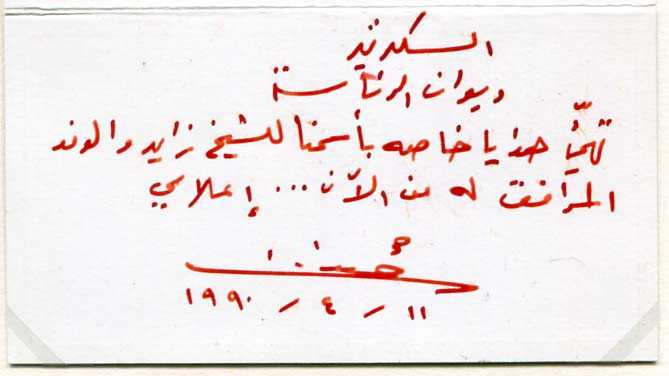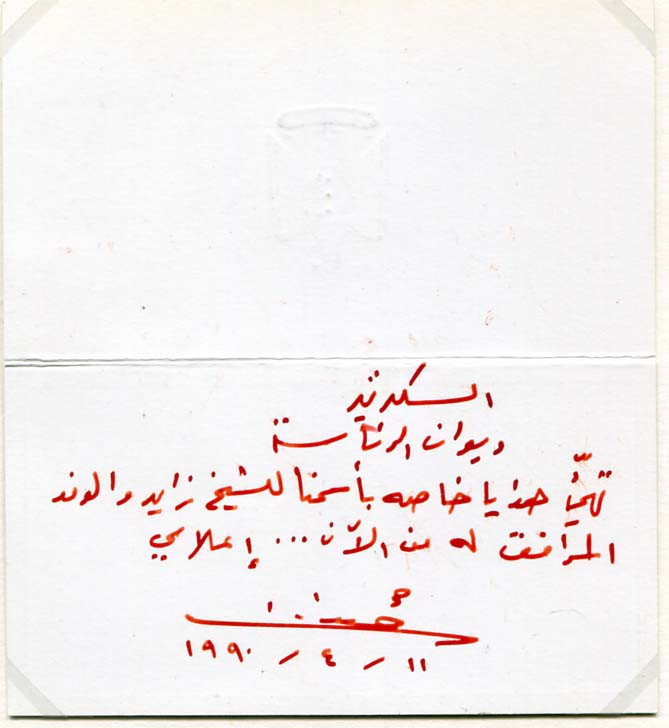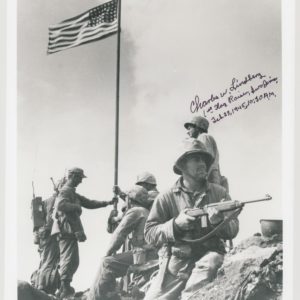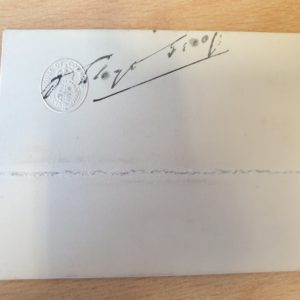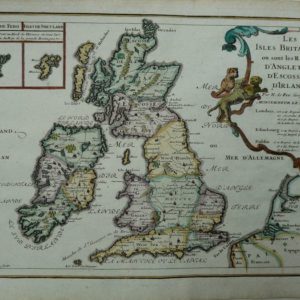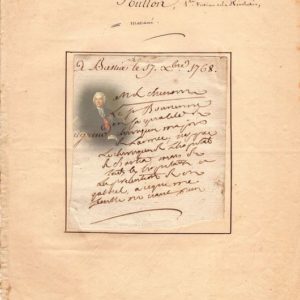Description
#Recently Sold############
Autograph note signed, one page (folding card), 4,25 x 2,25 inch (folded), concerning the handing over of a gift, untranslated, written and signed in red felt tip, attractively mounted (removable) for display with a photograph, shows Saddam Hussein at an event (altogether 8,25 x 11,75 inch), with very mild signs of wear – in nearly very fine condition. Comes with a Certificate of authenticity.
This autograph comes from Sadun Hammadi, a former minister and member of the Revolutionary Command Board.
Saddam Hussein (1937-2006) joined the Pan-Arab socialist Baath Party in 1957 and fled Iraq. He was wounded two years later, after attempting to assassinate Prime Minister Kassim. Returning to Iraq after Kassim’s overthrow in 1963, he rose rapidly in the Baath revolutionary apparatus and by 1968 was a Vice President with broad authority over the secret police. Saddam seized full power in 1979 and conducted a ruthless purge of opponents inside and outside the Baath Party. He dealt brutally with political, ethnic and religious opponents, real or imagined, throughout his reign. In September, 1980, four months after signing this order, Saddam Hussein began an eight-year war with Iran which began well but soon turned into a stalemate costly in lives and money. It was partly to recover from the resulting financial crisis that Saddam invaded Kuwait in 1990. The Persian Gulf War with the United States and a coalition of many other nations crippled Iraq’s military, but Saddam retained his grip on power despite international economic sanctions and other international sanctions. Believing that Saddam had weapons of mass destruction, on March 17, 2003, after a U.S.-Great Britain resolution to the United Nations Security Council that called for the use of force failed to pass, President George W. Bush gave Saddam Hussein an ultimatum. Either he and his sons leave Iraq within 48 hours or the United States would pursue military action against Iraq. Two days later, the United States and other coalition forces started Operation Iraqi Freedom in an effort to remove Saddam Hussein and his regime from power. On April 9, 2003, jubilant crowds greeted U.S. troops in Baghdad, then toppled a large statue of Saddam. On December 13, 2003, Saddam Hussein was captured by U.S. troops in Adwar, ten miles south of Tikrit, while hiding in a specially prepared “spider hole”.
Saddam Hussein (1937-2006) joined the Pan-Arab socialist Baath Party in 1957 and fled Iraq. He was wounded two years later, after attempting to assassinate Prime Minister Kassim. Returning to Iraq after Kassim’s overthrow in 1963, he rose rapidly in the Baath revolutionary apparatus and by 1968 was a Vice President with broad authority over the secret police. Saddam seized full power in 1979 and conducted a ruthless purge of opponents inside and outside the Baath Party. He dealt brutally with political, ethnic and religious opponents, real or imagined, throughout his reign. In September, 1980, four months after signing this order, Saddam Hussein began an eight-year war with Iran which began well but soon turned into a stalemate costly in lives and money. It was partly to recover from the resulting financial crisis that Saddam invaded Kuwait in 1990. The Persian Gulf War with the United States and a coalition of many other nations crippled Iraq’s military, but Saddam retained his grip on power despite international economic sanctions and other international sanctions. Believing that Saddam had weapons of mass destruction, on March 17, 2003, after a U.S.-Great Britain resolution to the United Nations Security Council that called for the use of force failed to pass, President George W. Bush gave Saddam Hussein an ultimatum. Either he and his sons leave Iraq within 48 hours or the United States would pursue military action against Iraq. Two days later, the United States and other coalition forces started Operation Iraqi Freedom in an effort to remove Saddam Hussein and his regime from power. On April 9, 2003, jubilant crowds greeted U.S. troops in Baghdad, then toppled a large statue of Saddam. On December 13, 2003, Saddam Hussein was captured by U.S. troops in Adwar, ten miles south of Tikrit, while hiding in a specially prepared “spider hole”.


